TETON Sports Mammoth +20F Double-Wide Sleeping Bag; Double Sleeping Bag Perfect for Base Camp while Camping, Backpacking, and Hiking; Grey
When you want to cuddle while you camp, choose the TETON Sports Mammoth Sleeping Bag. It will give you the best night’s sleep with shoulder and zipper draft tubes, drawstrings at the shoulder and around the head, and double-layer construction with offset stitching to eliminate cold spots. It’s filled with SuperLoft Elite hollow fiber fill—all these features work together to keep you warm and comfortable anywhere you set up camp. If you get too warm, just unzip the bag a little at either corner or down the side. The bag comes apart in two massive quilts. Includes its own storage bag. Here’s a storage tip: Stuff the bag in, don’t try to roll it up and then put it back in the sack. Like all TETON Sports sleeping bags, the Mammoth Sleeping Bag comes with a Limited Lifetime Warranty.Stay light on your feet while hiking without settling for sleepless nights afterward with the Sportsman Lite sleeping bag. Designed specifically to cut weight but not space, the compressible bag is roughly the size of a roomy rectangular bag, with plenty of space for your feet and arms to stretch out. At the same time, the bag’s soft poly-cotton liner and durable ripstop nylon shell are no heavier than most mummy bags, so you needn’t worry about slowing down on the trail. And thanks to the bag’s cozy temperature rating of -20 degrees F, you’ll be prepared for all but the most extreme nighttime conditions.
Other features include an internal storage pocket that allows easy access to your keys, wallet, and other valuables; a shoulder baffle and a full-length zipper draft tube that keep warmth in and cold out; and an Oxford nylon compression sack that makes the Sportsman Lite easy to transport and store. The bag measures 80 inches long by 34 inches wide and weighs in at a manageable 7.7 pounds.
Amazon.com Sleeping Bag Guide
Sleep Well: Finding the Right Sleeping Bag
Sleeping bag technology has come a long way from the days of cowboy bedrolls. These days, there are a number of high-tech materials and designs available to keep you warm during the coldest outings. Here’s a short list of things to keep in mind when you’re shopping for a bag:
Buy for Cold
It’s a safe bet that on at least one of your adventures, the nighttime temperature will drop unexpectedly. That’s why it’s smart to buy a bag that’s rated for the lowest possible temperature you expect to face on your camping and backpacking trips. For summer trips, a bag rated at +35 degrees or higher will likely do the trick. If you like to camp in higher elevations in the summer, or if spring and fall outings are in your future, consider bags rated from +10 to +35. Winter adventurers should look for bags in the -10 to +10 range, while those on serious winter alpine climbs and expeditions will want a bag rated lower than -10.
Keep in mind that sleeping bag manufacturers’ temperature ratings only estimate the minimum temperature at which the bag will provide warmth. Take these numbers with a grain of salt, as different folks generate different amounts of heat when they sleep. If you’re the type who likes to pile on the covers even on warmer nights, go for a bag that’s rated ten degrees colder. The opposite is true for “warm” sleepers–a 35-degree bag will probably work for you on a 25-degree night.
Goose or No Goose?
The most important component of any sleeping bag is its insulating material. Modern sleeping bags offer two choices: goose down or synthetic. While both materials have advantages and disadvantages, down bags are considered superior because of their phenomenal warmth-to-weight and warmth-to-bulk ratios. While providing great insulation, down is extremely compressible and light. There’s a reason why geese can fly and stay warm through the winter! Down also boasts great long-term durability and will typically retain its insulating properties after years of use.
All of that said, there are many high-quality synthetic bags on the market and synthetic materials are getting better all the time. While a synthetic bag will weigh somewhat more than a down bag at an equivalent temperature rating, synthetic bags perform better when wet. (Yes, the Achilles heel of down is that it loses all insulating properties when wet.) If your trips take you to wet climates, you may want to consider a synthetic bag for this reason alone. Keep in mind, too, that many people are allergic to down–synthetic bags are non-allergenic. Finally, down is considerably more expensive than synthetic, which might tip the balance for adventurers on a budget.
Bags for All Shapes
Sleeping bags come in two basic shapes that reflect their intended use. Mummy-shaped bags offer the best warmth because they conform to the body’s contours. This minimizes the amount of body heat the body must put out to maintain a constant temperature. Many mummy bags are offered in women-specific shapes and sizes, as well. Rectangular bags, while they do offer more room to toss and turn, are less thermally efficient because they contain more open air space. Also, they are typically heavier than mummy bags, and are generally not offered with down insulation, making them best suited for car camping or short backpacking trips.
Pad Yourself
No matter what kind of bag you choose, a sleeping pad is a required accessory. Not only do they provide much-needed comfort when sleeping on the ground, pads also offer crucial warmth for your backside, as the weight of your body compresses–and renders virtually useless–the sleeping bag insulation that lies beneath you.
Product Features
- COMFORTABLE FAMILY SLEEPING BAG: Soft poly-flannel lining; Zipper and shoulder draft tubes keep the warm air in; Unzips on each side and the bottom for easy access; SuperLoft Elite fiber fill and double-layer construction work together to keep you warm
- TOUGH, DURABLE DOUBLE SLEEPING BAG: Warm from the time you get in flannel liner and tear-resistant taffeta shell can withstand years of use
- NEVER ROLL YOUR SLEEPING BAG AGAIN: TETON Sports provides a durable compression sack for stuffing your sleeping bag into; No need to roll it up and fight to get it in the sack; Simply start at the bottom and stuff the bag in; see our instructional videos
- SIZE DOES MATTER: Double sleeping bag is longer and wider than queen-sized mattress; 94×62 inches (239×157 cm)
- LIMITED LIFETIME WARRANTY: Your satisfaction is GUARANTEED; Reach out to our AMAZING customer service team if you have any questions or concerns; YOU CAN COUNT ON US to get you taken care of and back OUTDOORS with TETON Sports
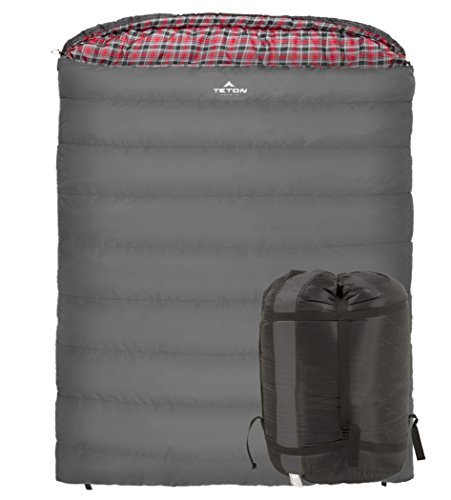



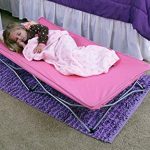
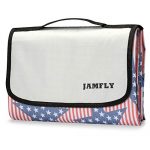
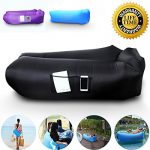
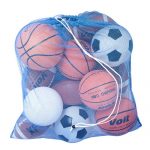
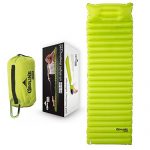
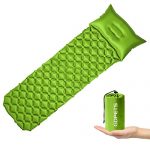
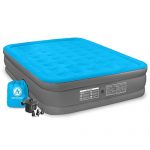
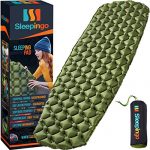
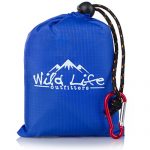
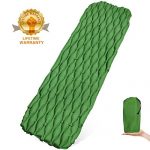
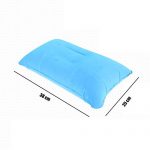
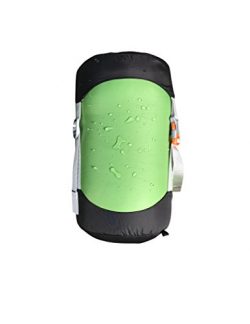

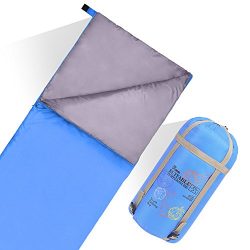
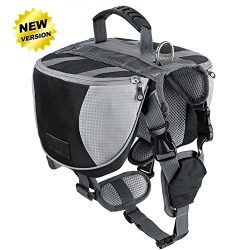
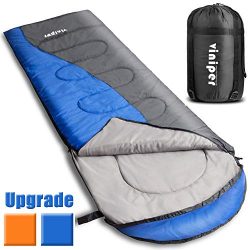

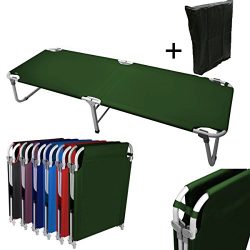
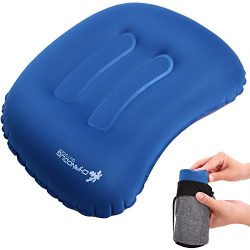
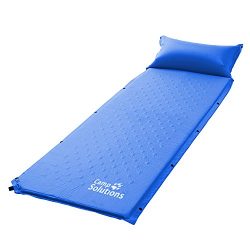
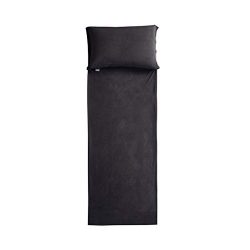
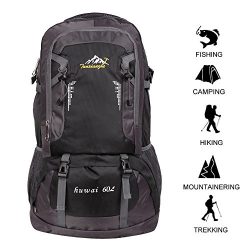
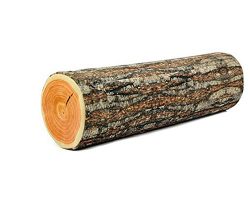
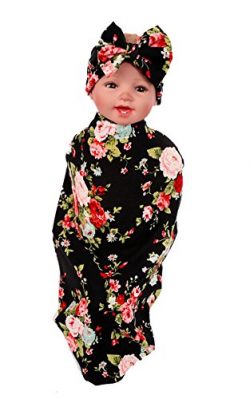
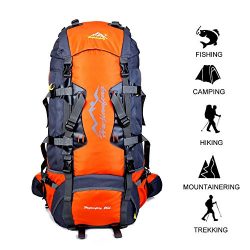

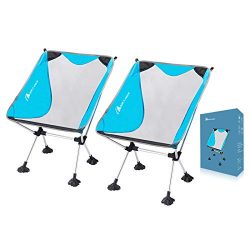
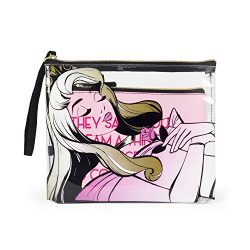
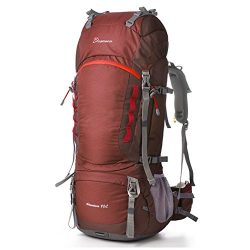

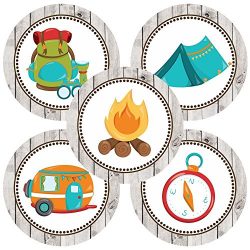
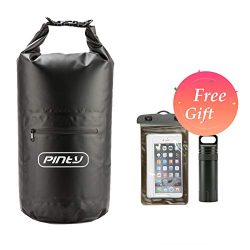

Great for couples, minimal layering needed, fantastic versatility! My wife and I recently got back into camping in the Colorado wilderness. It can be 90 in the city but once you get into the mountains, you’ve got to be prepared. We like to snuggle so instead of getting two bags and worrying about compatitibilty, I went with a double. We’ve used it twice now and we’re so happy with our decision. There are a few cons but definitely not enough to warrant a star’s deduction. Here are my thoughts:PROS- Assuming you have someone in the bag with…
We love this sleeping bag!! I read what seemed like a thousand reviews for every sleeping bag under the sun. I really wanted a sleeping bag that both my husband and I could sleep in together… one that would actually keep us warm on camping trips. We’ve spent many a freezing night huddled up trying to stay warm… The reviews for this bag led me to believe this could be the perfect bag.When we went to sleep the first night of using this, I was pretty sure we would be perfectly warm all night. It’s thick! This…
Great bag for the fam or if you need some room to move!